Lesson 7 – Contract Verbs, Liquid Verbs, Comparatives and Superlatives, Diaeresis
Contract Verbs
Some verbs are called “contract verbs” because in the present system (present and imperfect tenses) a contraction takes place when a personal ending is attached to the stem. When learning the contraction rules, it may be easiest to think of the personal ending in terms of the forms that include the connecting vowel. Remember that these are the familiar endings for the present tense:
Present Active
(connecting vowel + personal ending)
| singular | plural | |
| 1st person | ω | ομεν |
| 2nd person | εις | ετε |
| 3rd person | ει | ουσι |
The contract verbs have stems ending in a short vowel, either α, ε, or ο. These stem endings combine with sufformatives (connecting vowel + personal ending) in a contracted form according to the following chart:

As an example, consider the verb λαλέω. This is the form you would find as the entry in a lexicon, or in a list of vocabulary words. But this form will never occur in the Greek New Testament. Instead, the final ε in the stem λαλε- combines with the sufformative ω. Consulting the chart, you can determine what contracted form results from ε + ω…

So λαλε + ω = λαλω.
What about the accent mark? The placement of the accent mark can be determined by imagining what the placement would be if the verb were uncontracted. Then, if the accent mark falls on either of the syllables that will combine to form the contracted syllable, the resulting contracted syllable will be accented.
If the contracted syllable is accented and is the ultima, it will have a circumflex accent. For example, λαλέω contracts to form λαλῶwith circumflex on the ultima.
If the contracted syllable is not the ultima, the type of accent will be determined by the general rules you already know.
Consider the imperfect active indicative, 1st person singular of the same verb.
Imperfect Active
(connecting vowel + personal ending)
| plural | ||
| 1st person | ον | ομεν |
| 2nd person | ες | ετε |
| 3rd person | ε | ον |
ἐλαλε + ον
First, imagine the verb uncontracted. What syllable would be accented and what kind of accent would it have?
ἐλαλε + ον –> ἐλάλεον
What vowels are going to combine in the contraction?
ἐλάλεον
Now consult the table to see how they should be contracted…

Then the contracted form is ἐλάλουν.
This contraction of the final stem vowel in contract verbs occurs only in the present system. This is because in the other principal parts, a consonant is the first letter in the sufformative. However, in most contract verbs, the final stem vowel is lengthened outside the present system. For example, the future of λαλέω is λαλήσω, the aorist act. is ἐλάλησα, the perfect active is λελάληκα, the perfect middle is λελάλημαι, the aorist passive is ἐλαλήθην, and the future passive is λαληθήσομαι.
View the present system (indicative mood) of ἀγαπάω, ποιέω, and πληρόω, the most frequently occuring -αω, -εω, and -οω verbs respectively.
There are different ways to teach contraction. The method above is that used by James Hewett in New Testament Greek, A Beginning and Intermediate Grammar. Specifically, the chart used above is adapted from Hewett’s chart on p. 120 of his text book. Another method is that found in the classic beginning grammar by J. Gresham Machen, New Testament Greek for Beginners (p. 143ff). This method stipulates a set of verbal rules for forming contractions. More recently, in the popular Basics of Biblical Greek (p. 133ff), William D. Mounce reverses this. He encourages the student to think first of the contracted form, and then discern how it came to be. Whether viewed from the contracted form first or from the component form first, it is useful to understand these rules because they hold generally, and not only with respect to the particular contractions discussed in this lesson. For example, look back at lesson 4 to see a vowel contraction you previously learned. It can now be accounted for in terms of the same rules that govern the particular verbs known as contract verbs.These rules are as follows:
Rules of Vowel Contraction
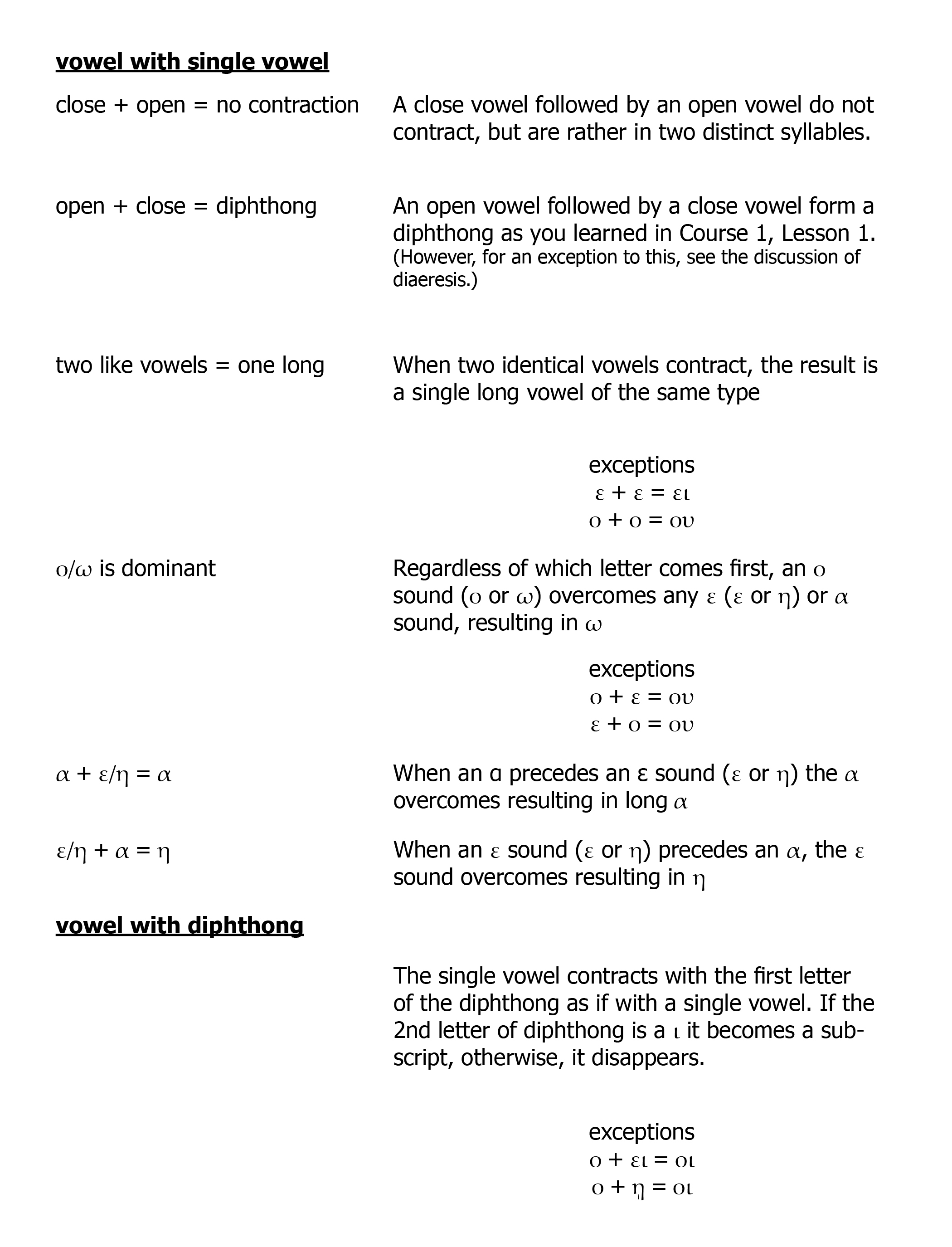
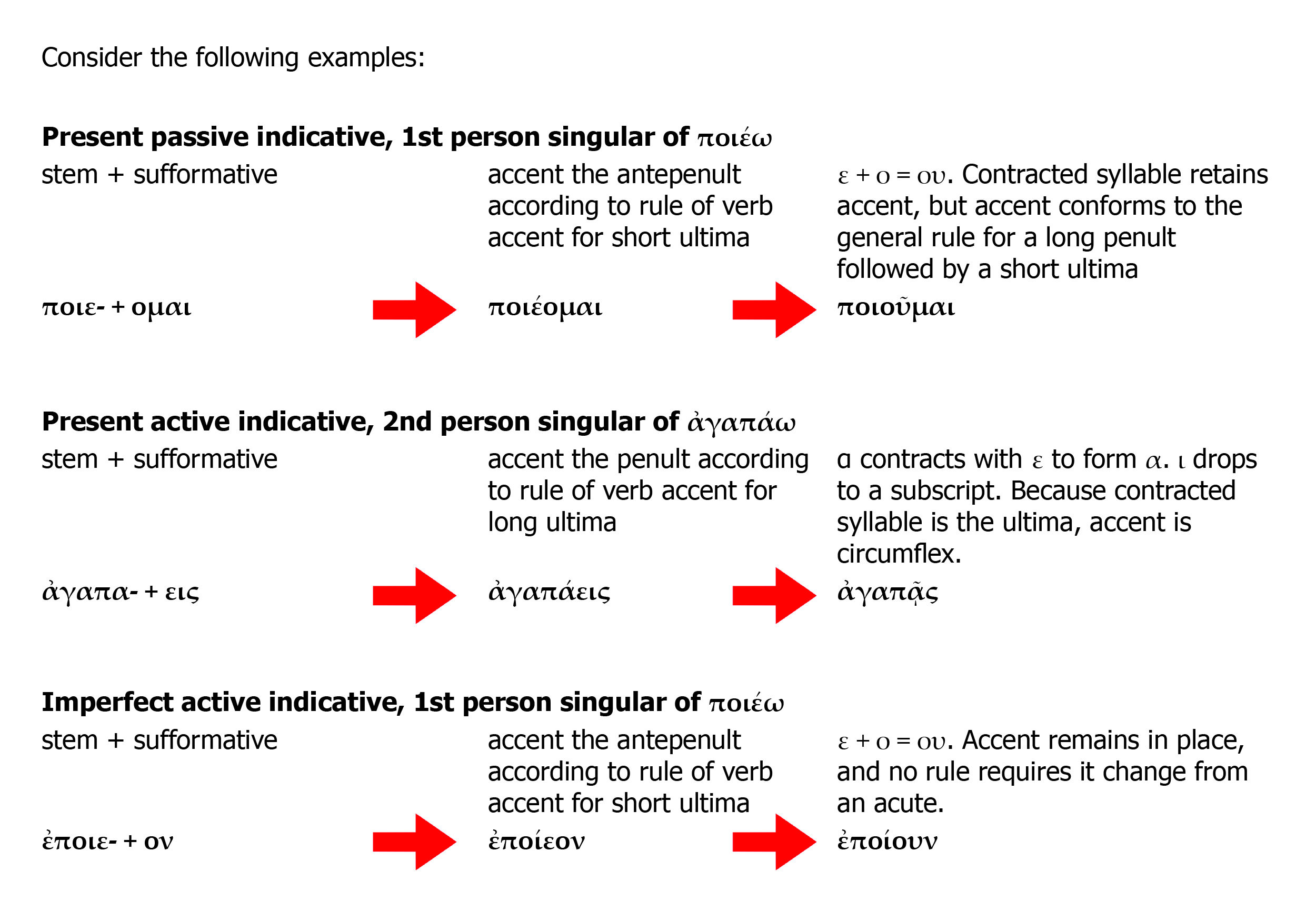
Liquid Verbs
In grammar, the term liquid is used of “a nonfrictional and vowel-like consonant; a letter with a smooth, flowing sound” (Webster’s New Twentieth Century Dictionary, 2nd ed.). In order to have a context in which to understand the term liquid, you might find it helpful to look over the classification of all Greek consonants.
The term liquid has not been used consistently with reference to the Greek alphabet. One grammar (Greek Grammar, by Hadley and Allen) classifies as liquids λ, μ, ν, ρ, and γ nasal (γ immediately preceding κ, ξ, χ or another γ). Another (Grammar of New Testament Greek, Vol. 2, Accidence and Word Formation by J. H. Moulton and W. F. Howard) classifies as liquids only those that are also non-nasal, λ and ρ (p. 41; however, it is allowed that μ and ν are often considered liquids, and in fact even elsewhere in this same volume, they are described as nasal liquids). In any event, liquid verbs are those having stems ending in λ, μ, ν, or ρ.
Liquid verbs require special attention primarily because for these verbs, some of of the clues on which you have come to rely to identify the future tense and the aorist tense will not work.
Liquid Futures
For the future tense, you have learned to look for σ attached to the stem. But this σ is not present in the future forms of liquid verbs. This is because an ε is first added to the liquid stem, and the σ, which would now stand between the ε and the connecting vowel, drops out. This brings the ε together with the connecting vowel and personal ending, resulting in a contraction in accordance with the rules given above. This results in two peculiarities that will help you to recognize a form as a future of a liquid verb:
(1) As in the contract verbs (those with stems ending in α, ε, or ο), because of the contraction, the accent mark will often be one syllable closer to the end than you would expect (i.e. when the ultima is short, the accent mark will often be on the penult, and when the ultima is long, the accent will often be on the ultima); and when on the ultima, the accent will always be a circumflex.
(2) Where you would expect to see simply an ο as a connecting vowel, you will see ου because ε + ο = ου.
Of course, these are similar to characteristics of contract verbs, and especially similar to those with stems ending in ε. However, the point at issue here is not identifying the verb as contract verb or liquid verb. You should be able to do that by being familiar with the root word. You would recognize that τιμάω is a contract verb, and you would also know that μένω is not a contract verb. Rather the point at issue here is distinguishing between future forms and present forms of liquid verbs.
It may occur to you that the accent mark might be the only thing to distinguish a future tense liquid verb from the present tense of the same verb. And indeed, this is sometimes true. For example, compare the present tense κρίνω and the future tense κρινῶ. However, often, the stem used in the present system will have an internal spelling variation from the stem used in the future system, as in the case of present tense βάλλω and future tense βαλῶ.
Liquid Aorists
For the (1st) aorist tense, you have learned to look for σα attached to the stem. But the σ is not present in the aorist forms of liquid verbs. Instead, there may be other changes to the stem. However, these are not necessarily 2nd aorist verbs. Most often, they are first aorist verbs and therefore they retain the α before the personal endings, and will omit the ν in the active voice, 1st person singular just as other 1st aorists do.
Study the first present, future, and aorist of μένω.
Comparatives and Superlatives in Adjectives
Consider the adjectives good, better, and best. Good is an adjective in the positive degree. It simply modifies a noun without making any comparison. The statement, “This is a good apple” doesn’t say anything about the apple in comparison with some other apple. Another apple may be equally good, or not.
Better is an adjective in the comparative degree. “This apple is better than that one.”
Best is an adjective in the superlative degree. “This is the best apple.”
In English, adjectives in the comparative degree often end in –er, and adjectives in the superlative degree often end in -est.
large, larger, largest
small, smaller, smallest
Comparatives in -τερος, Superlatives in -τατος
In Greek, adjectives in the comparative degree often have sufformatives beginning with τερ. Remember that adjectives are declined for gender, case, and number. Accordingly, the comparative endings can be…
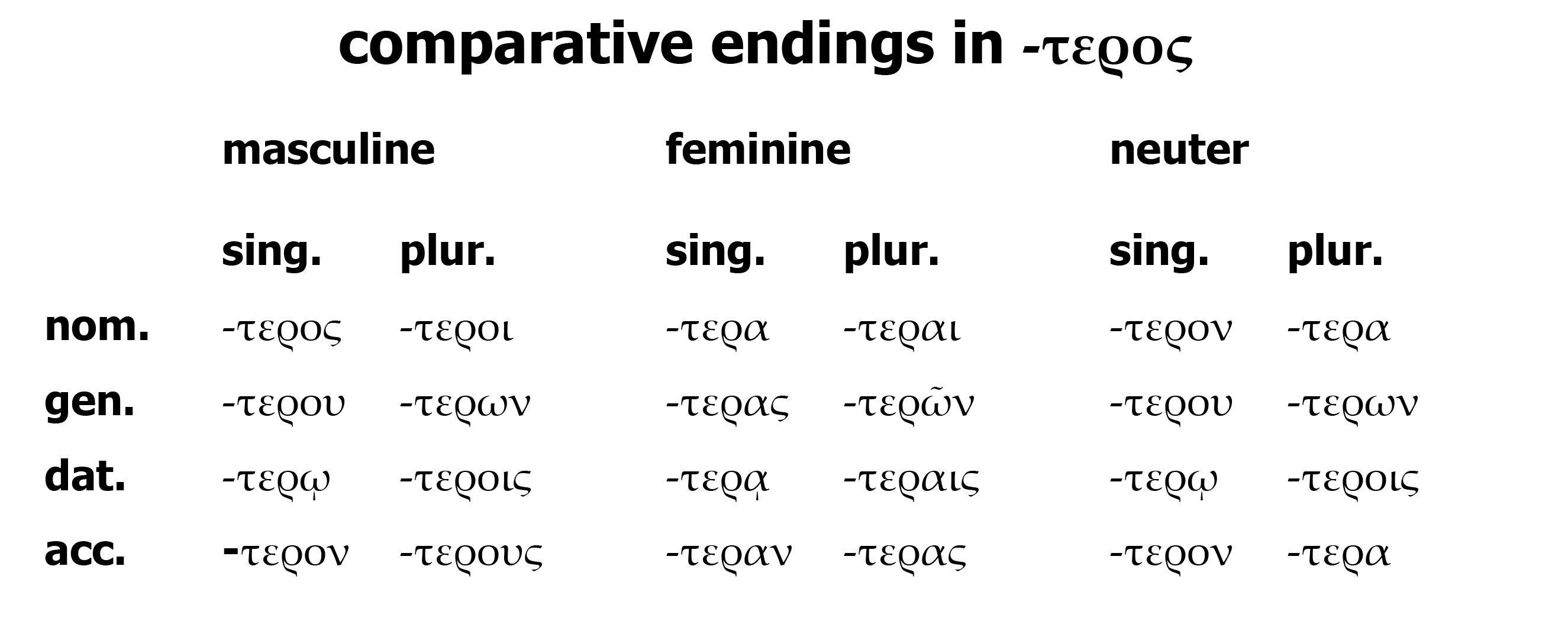
These endings are affixed to the masculine stem of the positive. For example, νέος, α, ον, is the adjective meaning new, fresh, young. The comparative is formed on the stem νεο-. However, the omicron in the stem of such adjectives is often lengthened. So for example Lk. 15:13 has ὁ νεώτερος υἱός, the younger son. Note that even when the adjective is feminine, it is built on this same stem, νεο-, not νεα- (and again the omicron is lengthened). So for example in the LXX, Gen. 29:26 has τὴν νεωτέραν, the younger, with reference to Rachel, the younger sister of Leah.
The corresponding superlative forms have sufformatives beginning with τατ…
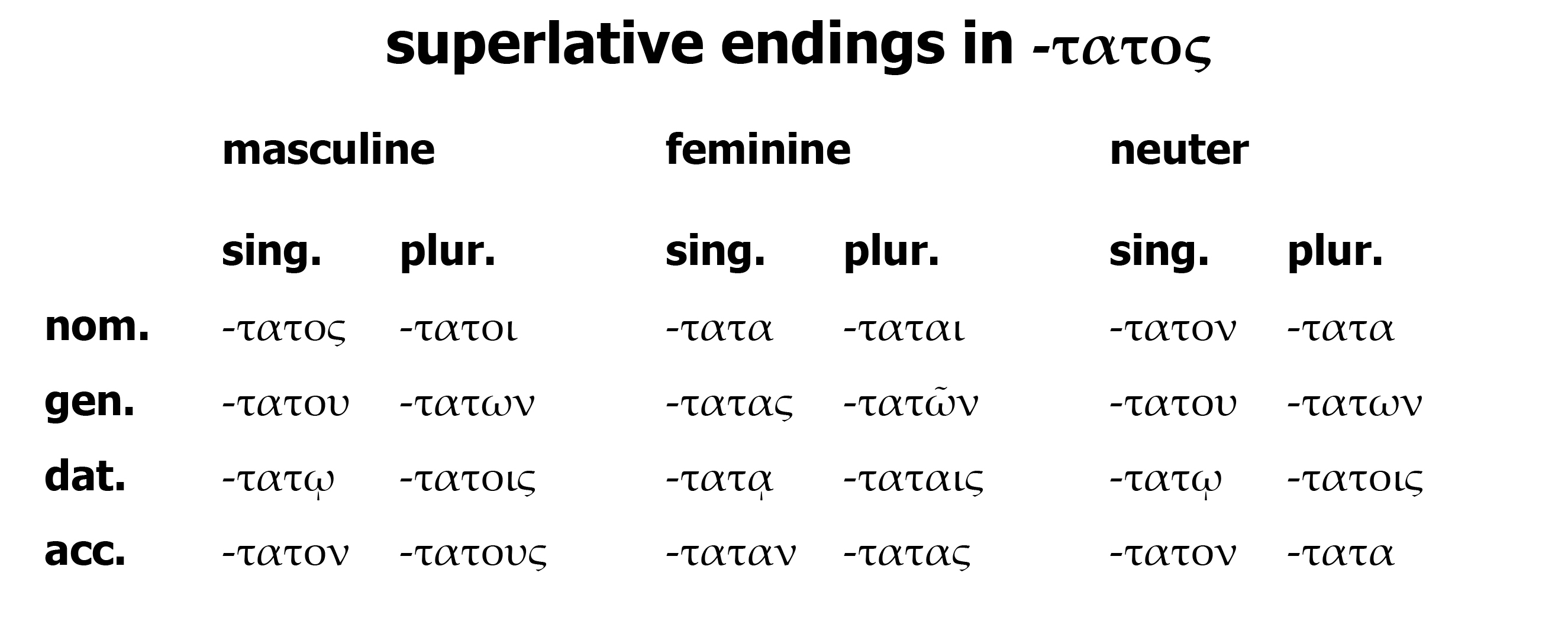
As with the comparatives, these endings are affixed to the masculine stem of the positive. And again, the omicron in the stem of such adjectives is often lengthened.
In the New Testament, superlatives do not occur frequently, their place often being filled by comparatives used with a superlative force.
Comparatives in -ιων, Superlatives in -ιστος
Some adjectives form comparatives using the endings -ιων (masc. and fem.) and -ιον (neuter) declined according to the 3rd declension. These adjectives form superlatives using -ιστος, -ιστη, -ιστον. The comparatives and superlatives of these adjectives are formed on the root word rather than on the masculine form of the positive. The ι in the comparatives sometimes moves to an internal position in the stem. Consider μείζων, greater, the comparative of μέγας, great. The comparative form is declined below:
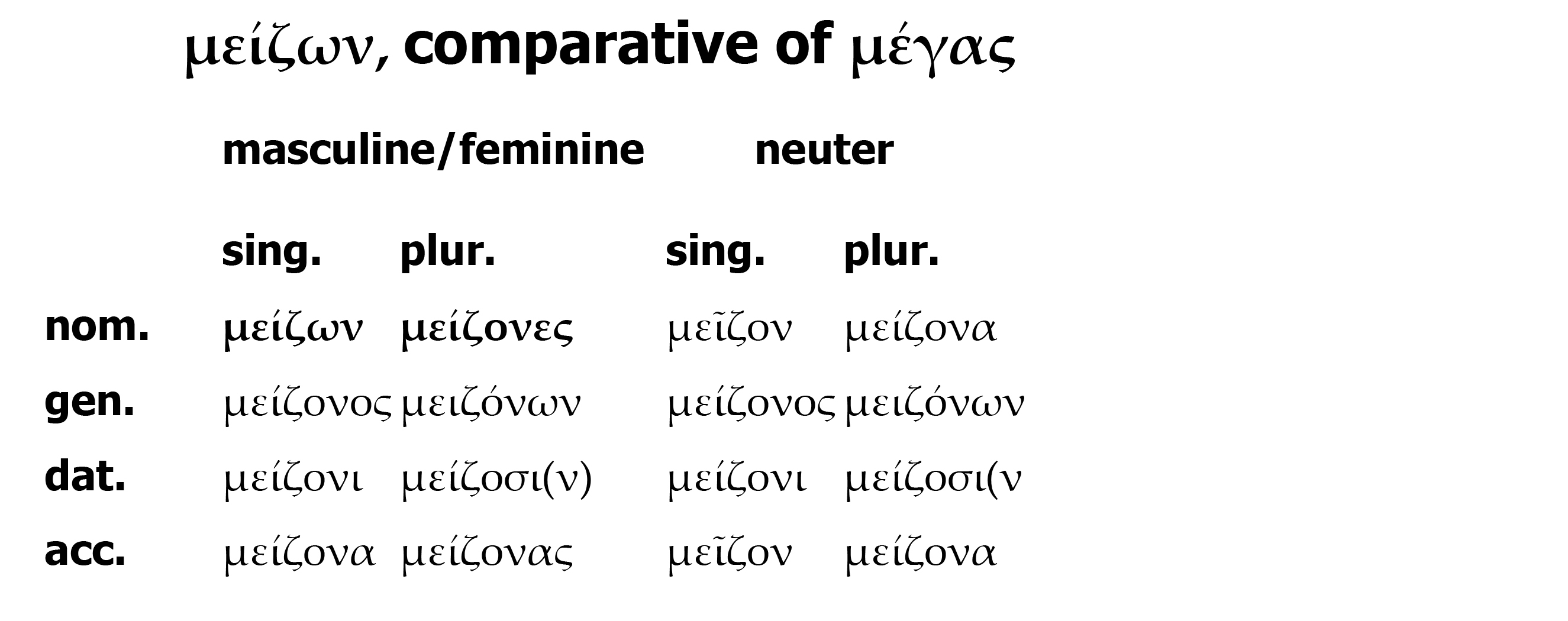
Diaeresis
In some exceptional words, an open vowel may be followed by a close vowel but no diphthong is formed. Instead the two letters stand in distinct syllables. To indicate this, the second vowel is marked with a diaeresis, two dots over the letter. This is often seen in words that came to Greek from another language, especially proper nouns that were simply transliterated into Greek. Some examples are Μωϋσῆς (3 syllables), Γάϊος (3 syllables), Βηθσαϊδά (4 syllables). The word diaeresis itself comes to us from a Greek word, διαίρεσις (division), a compound of διά and αἵρεσις, the latter word being the source of our heresy and meaning sect, party.
